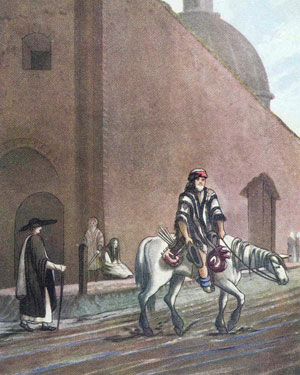|

Beggar on horseback
(Emeric Essex Vidal, 1820) |
This aspect of the life in the Pampas
levelled the whole population, rendering them a uniform
horse-riding people, a fact that was amazing in the eyes
of English and Irish visitors, accustomed to the familiar
figure of landlords - and sometimes large farmers, but
rarely peasants or labourers - on horseback. Moreover, in
Buenos Aires ‘the mounted beggar stands at the corner of
the street, and asks charity; his horse is no more proof
of his being undeserving of alms than the trowsers [sic]
of the English mendicant’ (Caldcleugh 1825: I, 172).
‘[H]is manner is essentially different from that of the
real object of charity. He accosts you with assurance and
a roguish smile; jokes on the leanness of his horse,
which, he says, is too old to walk; hopes for your
compassion, and wishes you may live a thousand years
(Essex Vidal 1820: 52). Rather than social scandal, these
views excited the imaginations of the Irish immigrants
and, particularly, of their fellow countrymen and women at
home. If anyone (even beggars) in the Pampas could own a
horse, by analogy the dream of land ownership could be
realised, and upward social mobility - becoming a
landowner - could become a reality for the industrious
young tenant farmers of Ireland.
Pato,
maroma, and cuadreras
From the early seventeenth century, following the fashion of
other Spanish and Portuguese colonies, bullfighting was
the most important social amusement among the people of
Buenos Aires, Montevideo and other locations in the Río de la Plata
region. Local versions of the corridas, in which
the torero kills a bull assisted by lancers on
horseback and flagmen, were developed. Wild bulls and cows
were mounted by expert riders (toreo a la
americana),
and complementary fights between teams of smart
horse-riders armed with canes were organised (juegos de
cañas). The latter game was eventually replaced by
pato (‘duck’), in which two, three or four teams of
several accomplished riders struggled for the possession
of a rawhide bag containing a live duck, and to carry it
to the big house of their own estancia. Among other
popular pastimes among gauchos on horseback were
pechadas, during which the players would violently
shove each other until the winner would be the only one
still on the mount, and maroma, which consisted of
jumping from a high gate or tree on to the back of a horse
galloping at full speed. [4]
Certainly the most popular entertainment in the Pampas
was horseracing. The local form, cuadreras, was
performed during holidays or on the day after a successful
round-up of wild cattle. The differences with British
races were observed and accounted for by Essex Vidal:
Horse-racing is a favourite diversion of the people of
Buenos Ayres, but it is so managed as to afford little
sport to an Englishman. There are no horses trained for
racing, nor is attention paid to the breed with a view to
that object. No match is ever made for more than half a
mile; but the ordinary distance is two quadras, or three
hundred yards, and the race is decided in a single heat.
To make amends for this, however, they will start more
than twenty times, and after running a few yards, return,
until the riders can agree that the start is equal
(Essex Vidal 1820: 113).
There were never more than two horses in the same race, and
the winner’s advantage must always be con luz
between the horses, that is, upon arrival there should
always be a distance between the first’s back and the
second’s nose. It was not allowed for racers to jostle the
adversaries off the course, but they could throw ‘one
another out of their seat, which is allowed, if it can be
accomplished; but with such expert riders it is extremely
difficult, and therefore seldom attempted’ (113). In ‘The
Defeat of Barragan’, William Bulfin tells of the intense
conclusion of a race between the hero Castro and the
villain Barragan, who
closes in
and tries to jostle as they race. Castro, holding the top
of his head against the whistling wind, turns his face
sideways and, looking into the face of his adversary,
while he raises his right hand, shouts, “I defy you to do
it.” The other, flogging with all his might, edges in. It
is an old dodge! He has done it scores of times before;
but to-day he has met his master. As the breast of his
horse touches Castro’s right leg, my companion [Castro]
lifts his whip, which in the meantime he has gripped by
the tail. Two swift strong cuts and he is free, […] amidst
the cheers of his hundreds of backers leaves the bayo
nowhere. Barragan […] is entirely beaten. Castro has the
rest of the running to himself, and crosses the line
twenty yards ahead of his rival
(Bulfin
1997: 94). |

